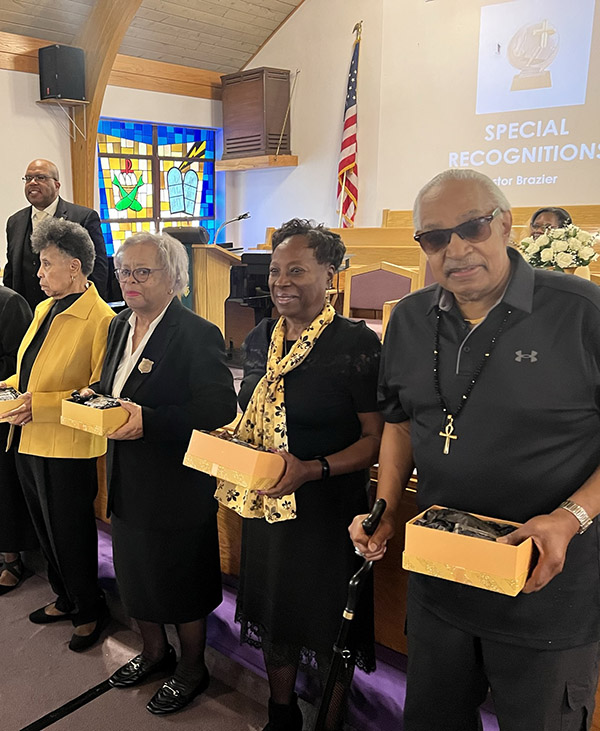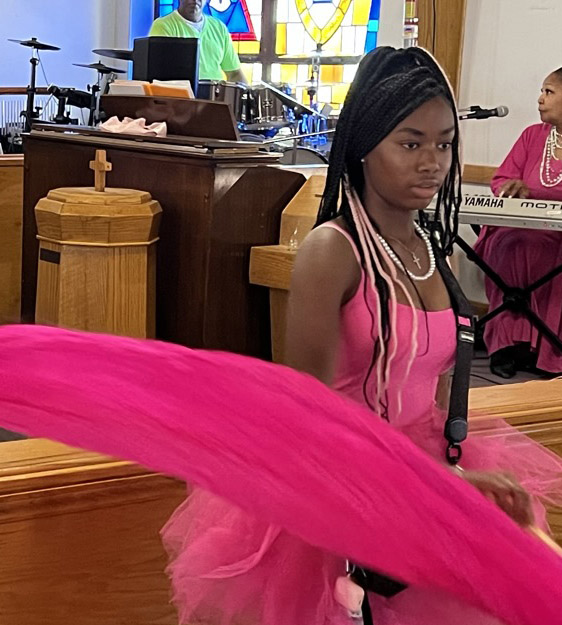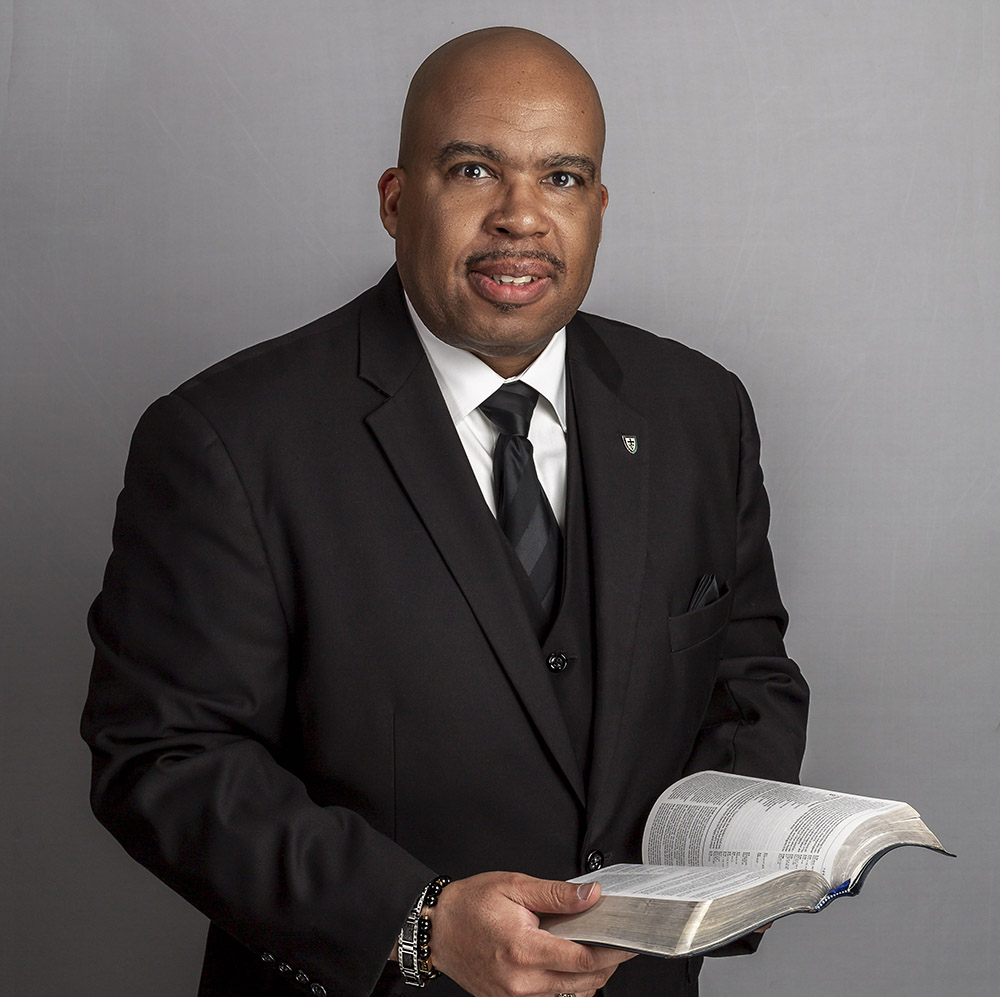




We Are Canaan AME
“Believing and Becoming” – 1 Timothy 4:10
That is why we labor and strive, because we have put our hope in the living God, who is the Savior of all people, and especially of those who believe.
Mission Statement: Exemplify Servant-Leadership in the Village of Maywood and the surrounding area by meeting the needs of the community through intentional evangelistic efforts, youth outreach and spiritual development-related ministries.
Our Services
Sunday
School
Conference Call (1st, 2nd & 3rd SUNDAYS)
Phone: (605) 475-4700
Access Code: 371839#
In-Person (4th SUNDAYS)
Sundays @ 9am – 10am
Morning
Worship
Sundays
10:30am
OUR PASTOR
Rev. Marland J. Brazier
Rev. Marland Brazier currently serves as the Pastor of Canaan African Methodist Episcopal (AME) Church in Maywood, IL. Prior to his pastoral appointment in October 2018 by Bishop John Franklin White, Presiding Prelate of the 4th Episcopal District of the AME Church, Rev. Brazier served as the Pastor of Miller Chapel AME Church in University Park, IL.
Professionally, Rev. Brazier has been employed with a leading Human Capital Management vendor for twenty-five (25) years where he is currently a Client Success Executive.
He has earned both a Bachelor of Arts in Political Science/Business Administration and Master of Science degree in Educational Administration/Higher Education (College Student Personnel) from Southern Illinois University at Carbondale. He received his Master of Divinity degree from Garrett-Evangelical Theological Seminary (on the campus of Northwestern University) in May 2016 and also holds a completed Professional Certificate in Youth & Theology from Princeton Theological Seminary in Princeton, NJ.
Currently, he is pursuing a Doctor of Ministry in Strategic Leadership of Black Congregations (Garrett) and an Executive Scholars Certificate in Nonprofit Management/Leadership (Northwestern-Kellogg) with an expected completion in December 2024.
Rev. Brazier was ordained an Itinerant Elder in the African Methodist Episcopal Church at the 134th Session of the Chicago Annual Conference in October 2016. He is also a proud member of Alpha Phi Alpha Fraternity, Inc.

Rev. Brazier currently resides in the Western Suburbs of Chicago with his wife, Raenette. Together, they have three daughters – Anisa, Jordyn and Zion.


GIVELIFY
ZELLE | canaaname@gmail.com
CASH APP | $CanaanMaywood
MAIL/DROP OFF | Canaan AME Church 801 S. 14th Ave. Maywood, IL 60153
Our History
- The AMEC grew out of the Free African Society (FAS) which Richard Allen, Absalom Jones, and others established in Philadelphia in 1787. When officials at St. George’s MEC pulled blacks off their knees while praying, FAS members discovered just how far American Methodists would go to enforce racial discrimination against African Americans. Hence, these members of St. George’s made plans to transform their mutual aid society into an African congregation. Although most wanted to affiliate with the Protestant Episcopal Church, Allen led a small group who resolved to remain Methodists. In 1794 Bethel AME was dedicated with Allen as pastor. To establish Bethel’s independence from interfering white Methodists, Allen, a former Delaware slave, successfully sued in the Pennsylvania courts in 1807 and 1815 for the right of his congregation to exist as an independent institution. Because black Methodists in other middle Atlantic communities encountered racism and desired religious autonomy, Allen called them to meet in Philadelphia to form a new Wesleyan denomination, the AME. The geographical spread of the AMEC prior to the Civil War was mainly restricted to the Northeast and Midwest. Major congregations were established in Philadelphia, New York, Boston, Pittsburgh, Baltimore, Washington, DC, Cincinnati, Chicago, Detroit, and other large Blacksmith’s Shop cities. Numerous northern communities also gained a substantial AME presence. Remarkably, the slave states of Maryland, Kentucky, Missouri, Louisiana, and, for a few years, South Carolina, became additional locations for AME congregations. The denomination reached the Pacific Coast in the early 1850’s with churches like Mother Bethel Church in Stockton, Sacramento, San Francisco, and other places in California. Moreover, Bishop Morris Brown established the Canada Annual Conference. The most significant era of denominational development occurred during the Civil War and Reconstruction. Oftentimes, with the permission of Union army officials AME clergy moved into the states of the collapsing Confederacy to pull newly freed slaves into their denomination. “I Seek My Brethren,” the title of an often repeated sermon that Theophilus G. Steward preached in South Carolina, became a clarion call to evangelize fellow blacks in Georgia, Florida, Alabama, Texas, and many other parts of the south. Hence, in 1880 AME membership reached 400,000 because of its rapid spread below the Mason-Dixon line. When Bishop Henry M. Turner pushed African Methodism across the Atlantic into Liberia and Sierra Leone in 1891 and into South Africa in 1896, the AME now laid claim to adherents on two continents.
- While the AME Church is doctrinally Methodist, clergy, scholars, and lay persons have written important works which demonstrate the distinctive theology and praxis which have defined this Wesleyan body. Bishop Benjamin W. Arnett, in an address to the 1893 World’s Parliament of Religions, reminded the audience of the presence of blacks in the formation of Christianity. Bishop Benjamin T. Tanner wrote in 1895 in The Color of Solomon – What? that biblical scholars wrongly portrayed the son of David as a white man. In the post civil rights era theologians James H. Cone, Cecil W. Cone, and Jacqueline Grant who came out of the AME tradition critiqued Euro-centric Christianity and African American churches for their shortcomings in fully impacting the plight of those oppressed by racism, sexism, and the economically disadvantaged. In the 1990s, the AME Church included over 2,000,000 members, 8000 ministers, and 7000 congregations in more than 30 nations in North and South America, Africa, and Europe. Twenty bishops and 12 general officers comprised the leadership of the denomination.
Our Denomination & Our Beliefs
 The word African means that the church was organized by people of African descent and heritage. It does not mean that the church was founded in Africa, or that it was for persons of African descent only. The church’s roots are of the family of Methodist churches. Methodism provides an orderly system of rules and regulations and places emphasis on a plain and simple gospel. Episcopal refers to the form of government under which the church operates. The chief executive and administrative officers of the African Methodist Episcopal denomination are the Bishops of the church.
The AME emblem is the cross and the anvil.
The word African means that the church was organized by people of African descent and heritage. It does not mean that the church was founded in Africa, or that it was for persons of African descent only. The church’s roots are of the family of Methodist churches. Methodism provides an orderly system of rules and regulations and places emphasis on a plain and simple gospel. Episcopal refers to the form of government under which the church operates. The chief executive and administrative officers of the African Methodist Episcopal denomination are the Bishops of the church.
The AME emblem is the cross and the anvil.The Mission of the African Methodist Episcopal Church is to minister to the spiritual, intellectual, physical, emotional, and environmental needs of all people. At every level of the Connection and in every local church, the African Methodist Episcopal Church shall engage in carrying out the spirit of the original Free African Society, out of which the A.M.E. Church evolved.
“God Our Father, Christ Our Redeemer, Holy Spirit Our Comforter, Humankind Our Family”
At every level of the Connection and in every local church, the AME Church shall engage in carrying out the spirit of the original Free African Society, out of which the AME Church evolved: that is, to seek out and save the lost, and to serve the needy. It is also the duty of Church to continue to encourage all members to become involved in all aspects of church training.
In order to meet the needs of every level of the Connection and in every local church, the AME Church shall implement strategies to train all members in: (1) Christian discipleship, (2) Christian leadership, (3) current teaching methods and materials, (4) the history and significance of the AME Church, (5) God’s biblical principles, and (6) social development to which all should be applied to daily living.
The Motto is a great summary of what the African Methodist Episcopal Church believes. Also known as the A.M.E. Church for short, the denomination is Methodist in terms of its basic doctrine and order of worship. It was born, through adversity, of the Methodist church and to this day does not differ in any major way from what all Methodists believe. The split from the main branch of the Methodist Church was not a result of doctrinal differences but rather the result of a time period that was marked by man’s intolerance of his fellow man, based on the color of his skin. It was a time of slavery, oppression and the dehumanization of people of African descent and many of these un-Christian practices were brought into the church, forcing Richard Allen and a group of fellow worshippers of color to form a splinter denomination of the Methodist Church. To find the basic foundations of the beliefs of the African Methodist Episcopal Church, you need look no further than The Apostles’ Creed and The Twenty Five Articles of Religion.